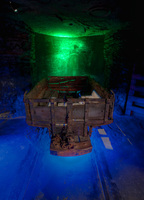
One of the best ways to learn about West Virginia is to visit the State Museum, located in the Culture Center.
The lobby of the museum is filled with cases that present a sample of the more than 60,000 artifacts collected by the West Virginia Division of Culture and History. On display here is one of museum’s most popular exhibits: Emmiline and Alexander, a pair of dressed fleas who began their career in a New York flea circus in the late 1800s.
Visitors then enter the first room along the “show path.” This path takes visitors from the state’s prehistoric era to modern times. The floor changes with the era, from stone to dirt to brick and finally, highway. Footprints embedded in the floor change from bare feet to shoes and even horseshoes. Each time period change is marked on the floor with a brass plaque. Overhead speakers tell the story of each era. Along the path are rooms that provide a feast for the eyes and ears. In each room, there are short films that provide more information.
The first room, the Coal Forest, is dark, with a ceiling of twinkling stars and displays of rocks and fossils, and a large block of coal. Featured in this area is Elkinsia Polymorpha, a plant fossil found in Randolph County that is recognized as the oldest seed-bearing plant in North America. Another case features famous hoaxes in West Virginia history, including the Braxton County Rune Stone.
From there the path leads around a bend of trees to rooms that highlight the pioneer era. Among the items on display is a telescope used by George Washington to survey tracts of land in the Eastern Panhandle and his own land along the Kanawha and Ohio rivers.
The path goes on to the Civil War era. As would be expected of a state created out of the Civil War, these exhibits are extensive and lively. There is one section devoted to John Brown’s raid on Harpers Ferry. There are also battlefield murals and audio complete with cannon fire.
Across a small-scale version of the Philippi covered bridge there are displays that explore the statehood movement. The path then takes visitors to a company store and then through a very realistic coal mine complete with railroad track and the sounds of dripping water. Displays highlight West Virginia’s many industries.
All along the path are numerous “discovery rooms” and “connections rooms” that offer opportunities to veer off the main road to see related displays.
These rooms contain some of the most interesting artifacts, including a real settler’s cabin that was rebuilt in the museum. The rooms also feature a complete library (walls and all) from a house built in Clarksburg in the 1880s, a 35-star flag flown over the cemetery at Gettysburg during Lincoln’s address, and a photo display about the building of the capitol. There is also a soda shop that was constructed, in part, from materials taken from the Scott Brothers Drug Store in downtown Charleston.
The main path takes visitors past a replica of Huntington’s Keith-Albee Theater (featuring seats taken from the theater) and through exhibits that focus on the many wars in which West Virginians have fought.
At this point many visitors might need a break, so there is a lounge to sit and relax next to big window. A bookcase provides reading material about the state. Across the room is another window with a view into the museum’s collection room. Preservationists continuously move items in this window so that more of the state’s holdings can be viewed.
The final portion of the path moves past a miniature New River Gorge Bridge to displays on West Virginia’s many fairs and festivals, then ends in a circle. Like spokes on a bike, three exhibit rooms leading from the circle feature painting and sculpture, crafts, and folk music. The last stop beyond the circle is a brief film of breathtaking West Virginia landscapes set to inspiring music. Then an escalator leads visitors back to the main level of the Culture Center.
Admission to the museum is free. Young visitors receive student fun packs. The museum is open 9 a.m. to 5 p.m. Tuesday through Saturday, noon to 5 p.m. on Sundays. For more information, call 304-558-0220 or go to www.wvculture.org
Written by Jennifer Bundy

